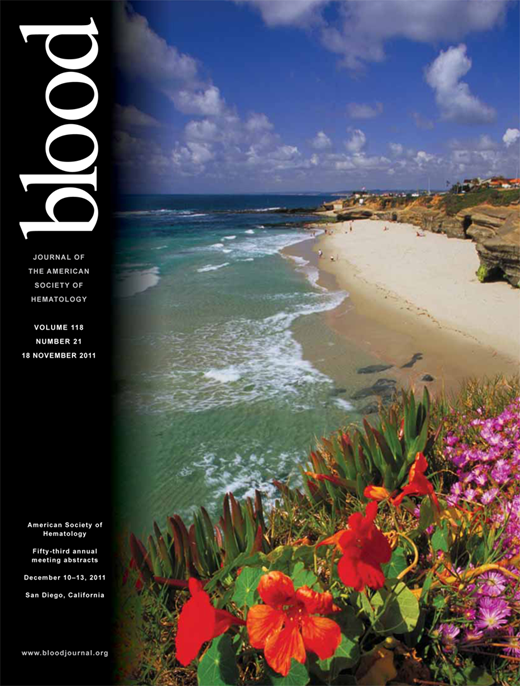Abstract
Abstract 4574
Leukocytosis has been documented as a risk factor for thrombotic events in various clinical conditions such as ischemic heart diseases, polycythemia vera, intensive chemotherapy and stem cell transplantation (SCT). Allogeneic (allo) SCT is characterized with a unique peri-engraftment phase simultaneously harboring T cell alloreactivity, endothelial damage, leukocyte elevation and an abundance of variable secreted cytokines. Whether leukocytes are a causative or surrogate marker for the underlying process is not concluded and whether leukocytosis is linked to the severity of acute graft-versus-host disease (aGVHD) has not been previously elucidated.
The study included 59 consecutive patients undergoing matched related or unrelated allo SCT for hematological malignancies at the Rambam Medical Center, Haifa, Israel in 2010. Median age 45 years (21–66), 35 males and 24 females. Conditioning protocols were either myeloablative with busulfan/cyclophosphamide or reduced intensity (busulfan or melphalan based). Patients' clinical course and blood counts were followed for 2 months and categorized into 3 groups according to their post-engraftment leukocyte counts and leukocytosis duration.
The outcome is summarized in the following table:
| Group . | Leukocyte count . | No. patients . | Median days to engraftment . | Median days to leukocyte >10x103/μl . | 120-day mortality . | Cause of death . |
|---|---|---|---|---|---|---|
| 1 | < 10X103/μl | 16 | +15 | 4/16 | 2 respiratory failure,1 relapse, 1 septic shock | |
| 2 | > 10x103/μl (< 7days) | 27 | +13 | +36 | 2/27 | 1 aGVHD (GI grade 4), 1 SOS* |
| 3 | > 10x103/μl (> 7 days) | 16 | +11 | +25 | 10/16 | 4 aGVHD (GI grade 4), 4 thrombotic events**, 2 idiopathic pneumonia with end organ failure and infective complications |
| Group . | Leukocyte count . | No. patients . | Median days to engraftment . | Median days to leukocyte >10x103/μl . | 120-day mortality . | Cause of death . |
|---|---|---|---|---|---|---|
| 1 | < 10X103/μl | 16 | +15 | 4/16 | 2 respiratory failure,1 relapse, 1 septic shock | |
| 2 | > 10x103/μl (< 7days) | 27 | +13 | +36 | 2/27 | 1 aGVHD (GI grade 4), 1 SOS* |
| 3 | > 10x103/μl (> 7 days) | 16 | +11 | +25 | 10/16 | 4 aGVHD (GI grade 4), 4 thrombotic events**, 2 idiopathic pneumonia with end organ failure and infective complications |
SOS- sinusoidal obstructive syndrome
2 SOS, 2 thrombotic thrombocytopenic purpura
+120 days were chosen as the cutoff to include patients dying of the mentioned complication after day +60.
The results summarized in the table suggest that patients with early and protracted leukocytosis post engraftment are at increased risk for severe and fatal complications (group 3). The 16 patients in this cohort included 9 in complete remission (CR); 7 with active disease; 5 sibling and 11 matched unrelated donor (MUD) SCTs; 6 myeloablative and 10 reduced intensity (RI) conditioning. This mix was similar to that of patients in groups 1 and 2. Leukocytosis occurring at a later phase (group 2) seems to have minimal or no impact on survival during the first 120 days post transplant. All deceased patients had documented platelet engraftment, although few did receive platelet concentrates as indicated clinically.
In conclusion, protracted leukocytosis post engraftment in allo SCT patients may be an independent risk factor not only for fatal thrombotic events but also for aGVHD, mostly gastrointestinal, although larger studies are needed to confirm this. The peri-engraftment syndrome may have long-term prognostic and therapeutic implications, beyond the immediate clinical management. Given that such patients are still with endothelial dysfunction and within a rich milieu of cytokines, incorporation of anti-aggregating agents (such as anti p-selectin or GPIIb/IIIa) in the treatment protocol at this stage may have a role and should be investigated. Furthermore, mechanisms leading to such leukocytosis also need to be assessed.
No relevant conflicts of interest to declare.
Author notes
Asterisk with author names denotes non-ASH members.

